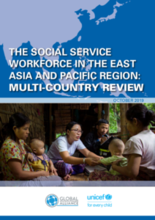The purpose of the multi-country review, undertaken by UNICEF East Asia and the Pacific Regional Office and the Global Social Service Workforce Alliance, is to provide an overview of the current status of social service workforces in the region and to identify good and promising practices for workforce strengthening, in order to inform advocacy, legal, policy and strategy development, and investment. The report presents the size, scope and structure of the social service workforce, efforts to strengthen the workforce through policy development, legislative reform, professionalization, education and training, and steps to strengthen the child protection system in 15 countries in East Asia and the Pacific: in-depth review - Cambodia, Indonesia, Mongolia, the Philippines, Thailand, and Viet Nam; desk review - Fiji, Kiribati, Lao People’s Democratic Republic, Malaysia, Myanmar, Papua New Guinea, Solomon Islands, Timor-Leste, and Vanuatu. The report highlights the unique aspects of each country’s workforce, identifies progress, challenges and gaps, and presents factors that countries may consider when engaging in social service workforce strengthening.
The report also provides a comparative regional review of progress against the three pillars of social service workforce strengthening: Planning the workforce - identifying the human resource needs and gaps for the child protection system and social welfare system; and ensuring that requisite laws, policies, and registration, accreditation and licensing system are in place for an effective workforce; Developing the workforce - providing effective and quality pre-service and in-service training and education that is aligned with needs and gaps in the workforce and prevailing accreditation systems, international best practices and the national context; Supporting the workforce - improving recruitment and retention of workers, including through improving job satisfaction and opportunities for career development and progression; enhancing performance of the workforce through quality supervision; supporting professional associations, which are empowered to set standards, including codes of ethics, and hold members of the profession accountable; and tackling negative public perceptions of the workforce.

